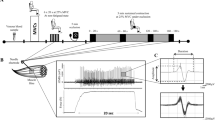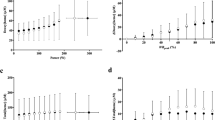Abstract
Purpose
Animal studies suggest that the inhibition of nitric oxide synthase (NOS) affects blood flow differently in different skeletal muscles according to their muscle fibre type composition (oxidative vs glycolytic). Quadriceps femoris (QF) muscle consists of four different muscle parts: vastus intermedius (VI), rectus femoris (RF), vastus medialis (VM), and vastus lateralis (VL) of which VI is located deep within the muscle group and is generally regarded to consist mostly of oxidative muscle fibres.
Methods
We studied the effect of NOS inhibition on blood flow in these four different muscles by positron emission tomography in eight young healthy men at rest and during one-leg dynamic exercise, with and without combined blockade with prostaglandins.
Results
At rest blood flow in the VI (2.6 ± 1.1 ml/100 g/min) was significantly higher than in VL (1.9 ± 0.6 ml/100 g/min, p = 0.015) and RF (1.7 ± 0.6 ml/100 g/min, p = 0.0015), but comparable to VM (2.4 ± 1.1 ml/100 g/min). NOS inhibition alone or with prostaglandins reduced blood flow by almost 50% (p < 0.001), but decrements were similar in all four muscles (drug × muscle interaction, p = 0.43). During exercise blood flow was also the highest in VI (45.4 ± 5.5 ml/100 g/min) and higher compared to VL (35.0 ± 5.5 ml/100 g/min), RF (38.4 ± 7.4 ml/100 g/min), and VM (36.2 ± 6.8 ml/100 g/min). NOS inhibition alone did not reduce exercise hyperemia (p = 0.51), but combined NOS and prostaglandin inhibition reduced blood flow during exercise (p = 0.002), similarly in all muscles (drug × muscle interaction, p = 0.99).
Conclusion
NOS inhibition, with or without prostaglandins inhibition, affects blood flow similarly in different human QF muscles both at rest and during low-to-moderate intensity exercise.


Similar content being viewed by others
Abbreviations
- NOS:
-
Nitric oxide synthase
- VI:
-
Vastus intermedius
- RF:
-
Rectus femoris
- VM:
-
Vastus medialis
- VL:
-
Vastus lateralis
References
Bradley SJ, Kingwell BA, McConell GK (1999) Nitric oxide synthase inhibition reduces leg glucose uptake but not blood flow during dynamic exercise in humans. Diabetes 48:1815–1821
Copp SW, Hirai DM, Hageman KS, Poole DC, Musch TI (2010a) Nitric oxide synthase inhibition during treadmill exercise reveals fibre-type specific vascular control in the rat hindlimb. Am J Physiol Regul Integr Comp Physiol 298:R478–R485
Copp SW, Hirai DM, Schwagerl PJ, Musch TI, Poole DC (2010b) Effects of neuronal nitric oxide synthase inhibition on resting and exercising hindlimb muscle blood flow in the rat. J Physiol 588:1321–1331
Duncker DJ, Heinonen IH (2012) Sympathetic limitation of exercise hyperemia: even hypoperfused muscle is not exempted. Front Physiol 3:411
Edgerton VR, Smith JL, Simpson DR (1975) Muscle fibre type populations of human leg muscles. Histochem J 7:259–266
Ferguson SK, Holdsworth CT, Wright JL, Fees AJ, Allen JD, Jones AM, Musch TI, Poole DC (2015) Microvascular oxygen pressures in muscles comprised of different fibre types: impact of dietary nitrate supplementation. Nitric Oxide 48:38–43
Frandsenn U, Bangsbo J, Sander M, Hoffner L, Betak A, Saltin B, Hellsten Y (2001) Exercise-induced hyperaemia and leg oxygen uptake are not altered during effective inhibition of nitric oxide synthase with N(G)-nitro-l-arginine methyl ester in humans. J Physiol 531:257–264
Heinonen I (2014) Muscle-specific functional sympatholysis in humans. Exp Physiol 99:344–345
Heinonen I, Nesterov SV, Kemppainen J, Nuutila P, Knuuti J, Laitio R, Kjaer M, Boushel R, Kalliokoski KK (2007) Role of adenosine in regulating the heterogeneity of skeletal muscle blood flow during exercise in humans. J Appl Physiol 103:2042–2048
Heinonen I, Kemppainen J, Kaskinoro K, Peltonen JE, Borra R, Lindroos MM, Oikonen V, Nuutila P, Knuuti J, Hellsten Y, Boushel R, Kalliokoski KK (2010a) Comparison of exogenous adenosine and voluntary exercise on human skeletal muscle perfusion and perfusion heterogeneity. J Appl Physiol 108:378–386
Heinonen IH, Kemppainen J, Kaskinoro K, Peltonen JE, Borra R, Lindroos M, Oikonen V, Nuutila P, Knuuti J, Boushel R, Kalliokoski KK (2010b) Regulation of human skeletal muscle perfusion and its heterogeneity during exercise in moderate hypoxia. Am J Physiol Regul Integr Comp Physiol 299:R72–R79
Heinonen I, Saltin B, Kemppainen J, Sipila HT, Oikonen V, Nuutila P, Knuuti J, Kalliokoski K, Hellsten Y (2011) Skeletal muscle blood flow and oxygen uptake at rest and during exercise in humans: a pet study with nitric oxide and cyclooxygenase inhibition. Am J Physiol Heart Circ Physiol 300:H1510–H1517
Heinonen I, Bucci M, Kemppainen J, Knuuti J, Nuutila P, Boushel R, Kalliokoski KK (2012a) Regulation of subcutaneous adipose tissue blood flow during exercise in humans. J Appl Physiol 112:1059–1063
Heinonen I, Duncker DJ, Knuuti J, Kalliokoski KK (2012b) The effect of acute exercise with increasing workloads on inactive muscle blood flow and its heterogeneity in humans. Eur J Appl Physiol 112:3503–3509
Heinonen I, Kemppainen J, Kaskinoro K, Peltonen JE, Sipila HT, Nuutila P, Knuuti J, Boushel R, Kalliokoski KK (2012c) Effects of adenosine, exercise, and moderate acute hypoxia on energy substrate utilization of human skeletal muscle. Am J Physiol Regul Integr Comp Physiol 302:R385–R390
Heinonen I, Nesterov SV, Kemppainen J, Fujimoto T, Knuuti J, Kalliokoski KK (2012d) Increasing exercise intensity reduces heterogeneity of glucose uptake in human skeletal muscles. PLoS One 7:e52191
Heinonen I, Saltin B, Kemppainen J, Nuutila P, Knuuti J, Kalliokoski K, Hellsten Y (2013a) Effect of nitric oxide synthase inhibition on the exchange of glucose and fatty acids in human skeletal muscle. Nutr Metab (Lond) 10:43
Heinonen I, Wendelin-Saarenhovi M, Kaskinoro K, Knuuti J, Scheinin M, Kalliokoski KK (2013b) Inhibition of alpha-adrenergic tone disturbs the distribution of blood flow in the exercising human limb. Am J Physiol Heart Circ Physiol 305:H163–H172
Heinonen I, Kalliokoski KK, Hannukainen JC, Duncker DJ, Nuutila P, Knuuti J (2014) Organ-specific physiological responses to acute physical exercise and long-term training in humans. Physiology (Bethesda) 29:421–436
Heinonen I, Koga S, Kalliokoski KK, Musch TI, Poole DC (2015) Heterogeneity of muscle blood flow and metabolism: influence of exercise, aging, and disease states. Exerc Sport Sci Rev 43:117–124
Hirai T, Visneski MD, Kearns KJ, Zelis R, Musch TI (1994) Effects of NO synthase inhibition on the muscular blood flow response to treadmill exercise in rats. J Appl Physiol 77:1288–1293
Johnson MA, Polgar J, Weightman D, Appleton D (1973) Data on the distribution of fibre types in thirty-six human muscles. An autopsy study. J Neurol Sci 18:111–129
Jones AM, Ferguson SK, Bailey SJ, Vanhatalo A, Poole DC (2016) Fibre type-specific effects of dietary nitrate. Exerc Sport Sci Rev 44:53–60
Kingwell BA, Formosa M, Muhlmann M, Bradley SJ, McConell GK (2002) Nitric oxide synthase inhibition reduces glucose uptake during exercise in individuals with type 2 diabetes more than in control subjects. Diabetes 51:2572–2580
Koga S, Rossiter HB, Heinonen I, Musch TI, Poole DC (2014) Dynamic heterogeneity of exercising muscle blood flow and O2 utilization. Med Sci Sports Exerc 46:860–876
Laughlin MH, Davis MJ, Secher NH, van Lieshout JJ, Arce-Esquivel AA, Simmons GH, Bender SB, Padilla J, Bache RJ, Merkus D, Duncker DJ (2012) Peripheral circulation. Compr Physiol 2:321–447
Mortensen SP, Gonzalez-Alonso J, Damsgaard R, Saltin B, Hellsten Y (2007) Inhibition of nitric oxide and prostaglandins, but not endothelial-derived hyperpolarizing factors, reduces blood flow and aerobic energy turnover in the exercising human leg. J Physiol 581:853–861
Radegran G, Saltin B (1999) Nitric oxide in the regulation of vasomotor tone in human skeletal muscle. Am J Physiol 276:H1951–H1960
Ruotsalainen U, Raitakari M, Nuutila P, Oikonen V, Sipila H, Teras M, Knuuti MJ, Bloomfield PM, Iida H (1997) Quantitative blood flow measurement of skeletal muscle using oxygen-15- water and PET. J Nucl Med 38:314–319
Sipilä HT, Clark JC, Peltola O, Teräs M (2001) An automatic [15O]-H2O production system for heart and brain studies. J Labelled Compd Radiopharm 44:S1066–S1068
Acknowledgements
The study was conducted within the Finnish Centre of Excellence in Molecular Imaging in Cardiovascular and Metabolic Research—supported by the Academy of Finland, University of Turku, Turku University Hospital and Abo Academy. Authors want to thank the contribution of the personnel of the Turku PET Centre for their excellent assistance during the study. The study was financially supported by the Ministry of Education of State of Finland, Academy of Finland, the Finnish Cultural Foundation and its South-Western Fund, the Finnish Sport Research Foundation, the Finnish Foundation for Cardiovascular Research, the Finnish Diabetes Research Foundation, Turku University Hospital (EVO funding), Novo Nordisk Foundation and the Danish Medical Research Council.
Author information
Authors and Affiliations
Corresponding author
Ethics declarations
Conflict of interest
None of the authors had personal or financial conflict of interest.
Additional information
Communicated by: Keith Phillip George
Rights and permissions
About this article
Cite this article
Heinonen, I., Saltin, B., Hellsten, Y. et al. The effect of nitric oxide synthase inhibition with and without inhibition of prostaglandins on blood flow in different human skeletal muscles. Eur J Appl Physiol 117, 1175–1180 (2017). https://doi.org/10.1007/s00421-017-3604-2
Received:
Accepted:
Published:
Issue Date:
DOI: https://doi.org/10.1007/s00421-017-3604-2




